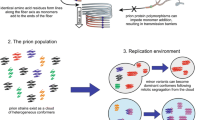Abstract
Discovery of prions—proteins that are able to convert between structurally distinct states, of which one or more is transmissible, led to the concept of “protein-based inheritance”. According to this concept, the formation of prion fibrils causes DNA-independent heritable traits in microorganisms. Recently, we described a new and unusual type of prion inheritance. We showed that the yeast prions [PIN +] and [SWI +], like classical genes, demonstrate complementary interaction that causes a phenotypic change in yeast cells. Here, we discuss the possible mechanisms of such polyprionic inheritance and the perspectives in the identification of prions in various organisms using universal proteomic approaches.

Similar content being viewed by others
References
Albuquerque CP, Smolka MB, Payne SH, Bafna V, Eng J, Zhou H (2008) A multidimensional chromatography technology for in-depth phosphoproteome analysis. Mol Cell Proteomics 7:1389–1396. doi:10.1074/mcp.M700468-MCP200
Burns LG, Peterson CL (1997) The yeast SWI-SNF complex facilitates binding of a transcriptional activator to nucleosomal sites in vivo. Mol Cell Biol 17:4811–4819
Chernoff YO (2004) Replication vehicles of protein-based inheritance. Trends Biotechnol 22:549–552. doi:10.1016/j.tibtech.2004.09.001
Chernoff YO, · Kiktev DA (2016) Dual role of ribosome associated chaperones in prion formation and propagation. Curr Genet 62:677–685. doi:10.1007/s00294-016-0586-2
Cox BS (1965) [PSI], a cytoplasmic suppressor of super-suppressor in yeast. Heredity 20:505–521
Derkatch IL, Bradley ME, Zhou P, Chernoff YO, Liebman SW (1997) Genetic and environmental factors affecting the de novo appearance of the [PSI +] prion in Saccharomyces cerevisiae. Genetics 147:507–519
Derkatch IL, Bradley ME, Hong JY, Liebman SW (2001) Prions affect the appearance of other prions: the story of [PIN(+)]. Cell 106(2):171–82
Derkatch IL, Bradley ME, Masse SV, Zadorsky SP, Polozkov GV, Inge-Vechtomov SG, Liebman SW (2002) Dependence and independence of [PSI(+)] and [PIN(+)]: a two-prion system in yeast? EMBO J 19:1942–1952. doi:10.1093/emboj/19.9.1942
Du Z, Li L (2014) Investigating the interactions of yeast prions: [SWI +], [PSI +], and [PIN +]. Genetics 197:685–700. doi:10.1534/genetics.114.163402
Du Z, Park KW, Yu H, Fan Q, Li L (2008) Newly identified prion linked to the chromatin-remodeling factor Swi1 in Saccharomyces cerevisiae. Nat Genet 40:460–465. doi:10.1038/ng.112
Kabani M, · Melki R (2016) More than just trash bins? Potential roles for extracellular vesicles in the vertical and horizontal transmission of yeast prions. Curr Genet 62:265–270. doi:10.1007/s00294-015-0534-6
Kryndushkin D, Pripuzova N, Burnett B, Shewmaker F (2013) Non-targeted identification of prions and amyloid-forming proteins from yeast and mammalian cells. J Biol Chem 288:27100–27111. doi:10.1074/jbc.M113.485359
Kulak NA, Pichler G, Paron I, Nagaraj N, Mann M (2014) Minimal, encapsulated proteomic-sample processing applied to copy-number estimation in eukaryotic cells. Nat Methods 11:319–324. doi:10.1038/nmeth.2834
Kushnirov VV, Ter-Avanesyan MD (1998) Structure and replication of yeast prions. Cell 94:13–16
Kushnirov VV, Alexandrov IM, Mitkevich OV, Shkundina IS, Ter-Avanesyan MD (2006) Purification and analysis of prion and amyloid aggregates. Methods 39:50–55
Lasagna-Reeves CA, Castillo-Carranza DL, Sengupta U, Guerrero-Munoz MJ, Kiritoshi T, Neugebauer V, Jackson GR, Kayed R (2012) Alzheimer brain-derived tau oligomers propagate pathology from endogenous tau. SciRep 2:e700. doi:10.1038/srep00700
Liebman SW, Sherman F (1979) Extrachromosomal psi+ determinant suppresses nonsense mutations in yeast. J Bacteriol 139:1068–1071
Luk KC, Kehm V, Carroll J, Zhang B, O’Brien P, Trojanowski JQ, Lee VM (2012) Pathological α-synuclein transmission initiates Parkinson-like neurodegeneration in nontransgenic mice. Science 338:949–953. doi:10.1126/science.1227157
Masuda-Suzukake M, Nonaka T, Hosokawa M, Oikawa T, Arai T, Akiyama H, Mann DM, Hasegawa M (2013) Prion-like spreading of pathological α-synuclein in brain. Brain 136:1128–1138. doi:10.1093/brain/awt037
Nizhnikov AA, Magomedova ZM, Rubel AA, Kondrashkina AM, Inge-Vechtomov SG, Galkin AP (2012) [NSI +] determinant has a pleiotropic phenotypic manifestation that is modulated by SUP35, SUP45, and VTS1 genes. Curr Genet 58:35–47. doi:10.1007/s00294-011-0363-1
Nizhnikov AA, Alexandrov AI, Ryzhova TA, Mitkevich OV, Dergalev AA, Ter-Avanesyan MD, Galkin AP (2014) Proteomic screening for amyloid proteins. PLoS ONE. doi:10.1371/journal.pone.0116003
Nizhnikov AA, Ryzhova TA, Volkov KV, Zadorsky SP, Sopova JV, Inge-Vechtomov SG, Galkin AP (2016) Interaction of prions causes heritable traits in Saccharomyces cerevisiae. PLoS Genet 12:e1006504. doi:10.1371/journal.pgen.1006504
Osherovich LZ, Weissman JS (2001) Multiple Gln/Asn-rich prion domains confer susceptibility to induction of the yeast [PSI +] prion. Cell 106:183–194. doi:10.1016/S0092-8674(01)00440-8
Paushkin SV, Kushnirov VV, Smirnov VN, Ter-Avanesyan MD (1996) Propagation of the yeast prion-like [psi +] determinant is mediated by oligomerization of the SUP35-encoded polypeptide chain release factor. EMBO J 15:3127–3134
Peterson CL, Herskowitz I (1992) Characterization of the yeast SWI1, SWI2, and SWI3 genes, which encode a global activator of transcription. Cell 68:573–583. doi:10.1016/0092-8674(92)90192-F
Prusiner SB (1989) Scrapie prions. Am Rev Microbiol 43:345–374
Saifitdinova AF, Nizhnikov AA, Lada AG, Rubel AA, Magomedova ZM, Ignatova VV, Inge-Vechtomov SG, Galkin AP (2010) [NSI +]: a novel non-Mendelian nonsense suppressor determinant in Saccharomyces cerevisiae. Curr Genet 56:467–478. doi:10.1007/s00294-010-0314-2
Sondheimer N, Lindquist S (2000) Rnq1: an epigenetic modifier of protein function in yeast. Mol Cell 5:163–172
Swaney DL, Beltrao P, Starita L, Guo A, Rush J, Fields S, Krogan NJ, Villén J (2013) Global analysis of phosphorylation and ubiquitylation cross-talk in protein degradation. Nat Methods 10:676–682. doi:10.1038/nmeth.2519
Wegrzyn RD, Bapat K, Newnam GP, Zink AD, Chernoff YO (2001) Mechanism of prion loss after Hsp104 inactivation in yeast. Mol Cell Biol 21:4656–4669
Wickner RB (1994) [URE3] as an altered URE2 protein: evidence for a prion analog in Saccharomyces cerevisiae. Science 264:566–569
Wickner RB (2016) Yeast and fungal prions. Cold Spring Harb Perspect Biol 8(9):a023531. doi:10.1101/cshperspect.a023531
Wickner RB, Taylor KL, Edskes HK, Maddelein ML, Moriyama H, Roberts BT (1999) Prions in Saccharomyces and Podospora spp.: protein-based inheritance. Microbiol Mol Biol Rev 63:844–861
Yang Z, Stone DE, Liebman SW (2014) Prion-promoted phosphorylation of heterologous amyloid is coupled with ubiquitin-proteasome system inhibition and toxicity. Mol Microbiol 93:1043–1056. doi:10.1111/mmi.12716
Acknowledgements
I am grateful to N. Degtyareva, A. Maltseva, J. Sopova, and S Zadorsky for the critical reading and help in the preparation of the manuscript. This work was supported by the Russian Science Foundation (14-50-00069 to SPbSU) and by SPbSU (grant for A.P.G.).
Author information
Authors and Affiliations
Corresponding author
Additional information
Communicated by M. Kupiec.
Rights and permissions
About this article
Cite this article
Galkin, A.P. Prions and the concept of polyprionic inheritance. Curr Genet 63, 799–802 (2017). https://doi.org/10.1007/s00294-017-0685-8
Received:
Revised:
Accepted:
Published:
Issue Date:
DOI: https://doi.org/10.1007/s00294-017-0685-8




